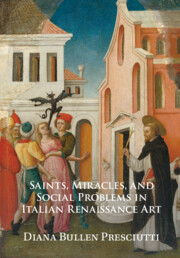Book contents
- Saints, Miracles, and Social Problems in Italian Renaissance Art
- Saints, Miracles, and Social Problems in Italian Renaissance Art
- Copyright page
- Contents
- Figures
- Acknowledgments
- One Introduction
- Two The Vita Icon Reimagined: New (and Old) Saints, New (and Old) Miracles
- Three Storytelling with Saints: Pictorial Narrative and Viewing Experience
- Four Girls in Trouble: Gendering Possession and Exorcism
- Five Assault, Amputation, Absolution: Visualizing the Power of Confession
- Six Thinking with Julian: Marital Violence and Elite Masculinity
- Seven Bernardino the Peacemaker: Visual Hagiography and Factional Violence
- Eight Cannibal Mothers: Picturing Madness and Maternal Infanticide
- Nine Making Innocence Visible (and Audible) in the Basilica del Santo
- Epilogue
- Bibliography
- Index
Epilogue
Published online by Cambridge University Press: 14 April 2023
- Saints, Miracles, and Social Problems in Italian Renaissance Art
- Saints, Miracles, and Social Problems in Italian Renaissance Art
- Copyright page
- Contents
- Figures
- Acknowledgments
- One Introduction
- Two The Vita Icon Reimagined: New (and Old) Saints, New (and Old) Miracles
- Three Storytelling with Saints: Pictorial Narrative and Viewing Experience
- Four Girls in Trouble: Gendering Possession and Exorcism
- Five Assault, Amputation, Absolution: Visualizing the Power of Confession
- Six Thinking with Julian: Marital Violence and Elite Masculinity
- Seven Bernardino the Peacemaker: Visual Hagiography and Factional Violence
- Eight Cannibal Mothers: Picturing Madness and Maternal Infanticide
- Nine Making Innocence Visible (and Audible) in the Basilica del Santo
- Epilogue
- Bibliography
- Index
Summary
The shifts in the ‘vita’ way of seeing observable in the Basilica del Santo speak to broader changes taking place in the sixteenth century. Between the installation of Antonio Lombardo’s Miracle of the Speaking Newborn (Fig. 144) and the final relief in the Cappella dell’Arca, The Miracle of the Resurrected Youth (Fig. 146), much had changed in the visual culture of miracles. By the 1520s, the predella – and its variant, the vita panel – had fallen from favor, largely supplanted by the single-field altarpiece. This shift can be partially explained by changing preferences in artistic patronage and production. The minutely-described anecdotal detail characteristic of the Erri Workshop and other fifteenth-century painters of miracle scenes was replaced by the increasingly monumental but more generalized styles of painters like Andrea del Sarto and Fra Bartolomeo. The few late predellas, like Garofalo’s ca. 1530 predella with miracles of Nicholas of Tolentino, from the Muzzarelli Chapel in Sant’Andrea, Ferrara, were among the last of their kind.1 My research has identified only a handful of post-Tridentine vita images of mendicant saints, among them a late-sixteenth century vita fresco of Bernardino of Siena in Sant’Antonio, Polla, and a seventeenth-century vita altarpiece of Nicholas of Tolentino in Sant’Agostino, Gubbio. These outliers aside, the visual phenomena I chart in this book largely ended in the first third of the sixteenth century.
- Type
- Chapter
- Information
- Saints, Miracles, and Social Problems in Italian Renaissance Art , pp. 330 - 338Publisher: Cambridge University PressPrint publication year: 2023



